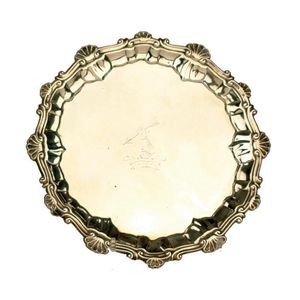1819 London Hallmarked Sterling Silver Armorials Tray
You must be a subscriber, and be logged in to view price and dealer details.
Subscribe Now to view actual auction price for this item
When you subscribe, you have the option of setting the currency in which to display prices to $Au, $US, $NZ or Stg.
- Sterling Silver - Sterling silver is a mixture of 92.5% pure silver and 7.5% of another metal, usually copper. Fine silver is 99.9% pure silver, and is relatively soft and the addition of the very small amount of copper gives the metal enough strength and hardness to be worked into jewellery, decorative and household objects.
- Hallmarks - A mark stamped on articles of precious metals in Britain, since the 14th century, certifying their purity. It derives its name from the Guild Hall of the Goldsmiths' Company, who recieved its Charter in 1327 giving it the power to assay (test the purity) and mark articles of gold and silver.
The hallmark will consist of several marks, including the:
- silver standard mark, indicating the purity of the metal. Sterling silver is .925 pure silver.
- the city mark indicating the city in which it was assayed eg London, Birmingham, York etc.
- the date mark, usually a letter of the alphabet in a particular font and case,
- a duty mark, indicating whether duty had been paid to the crown, and only in use from 1784 to 1890
The piece may include an additional mark, the maker's mark, although not forming part of the hallmark, will be located in the vicinity of the hallmarks.
Sometimes silver plated items will bear faux hallmarks, often confusing those not familiar with silver markings. - Armorial / Armourial - Bearing a coat of arms. Coats of arms came into general use by feudal lords and knights in in the 12th century, and by the 13th century, arms had spread beyond their initial battlefield use to become a flag or emblem for families in the higher social classes of Europe. They were inherited from one generation to the next. When a family crest is used on individual items of silver or furniture it is an indicator of the aristocratic standing of the family represented.
Armorials were also used to decorate mass produced ceramic souvenir ware by such companies as Goss, Carlton & Shelley, and in these cases the coats of arms displayed were of boroughs and cities.
This item has been included into following indexes:
- Barnard , Edward and John (London) - silver, maker or retailer 201
- trays, silver
Visually similar items

Silver plated presentation tray with pierced Pugin Gothic gallery 'Presented to the Rev. D. C. Booth by a Number of his Friends as a Testimonial of Respect on his Leaving St.Peter's Parish. Melbourne, December 1859'. Diameter 35.5 cm

An antique Mogul silver table top tray. Decorated with engraved and repousse work. Diameter 64.5 cm. Approx weight 1400grams

Turquoise, lapis lazuli and diamond ring, of bombe design centring an oval shaped cabochon turquoise framed by brilliant-cut diamonds on a raised surround decorated with lapis lazuli to a textured hoop, mounted in 18ct gold, size M

A rare fine quality George II crested silver waiter, engraved with a crest of a helmed arm grasping a fletched arrow issuing from a ducal coronet - with shell and scroll border and three pad feet. London 1759 by Ebenezer Coker. Weight 212gms. Diameter 17 c
